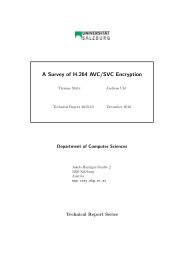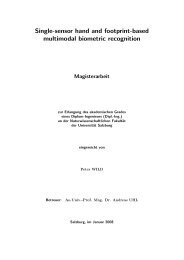Pit Pattern Classification in Colonoscopy using Wavelets - WaveLab
Pit Pattern Classification in Colonoscopy using Wavelets - WaveLab
Pit Pattern Classification in Colonoscopy using Wavelets - WaveLab
Create successful ePaper yourself
Turn your PDF publications into a flip-book with our unique Google optimized e-Paper software.
4 Automated pit pattern classification<br />
<strong>in</strong> any of the T i . This is the moment the flag f d,j stored along with the nodes of the<br />
dom<strong>in</strong>ance tree is used.<br />
After the prun<strong>in</strong>g process the dom<strong>in</strong>ance tree conta<strong>in</strong>s only nodes which are present<br />
at least once among all T i .<br />
4. Now a list D of all nodes <strong>in</strong> T D is created, which is then sorted by the counter c d,j<br />
stored along with the nodes of the dom<strong>in</strong>ance tree. The first entries of this sorted list<br />
are regarded as more relevant for feature extraction than those at the end of the list.<br />
This, as mentioned above, is due to the fact that a higher counter value means, that<br />
the accord<strong>in</strong>g node was marked as a feature node more often than nodes at the end of<br />
the sorted node list hav<strong>in</strong>g lower counter values.<br />
5. F<strong>in</strong>ally all feature vectors are recreated based on this list of dom<strong>in</strong>ance tree nodes.<br />
But <strong>in</strong>stead of us<strong>in</strong>g the cost <strong>in</strong>formation stored along with the nodes <strong>in</strong> T i to choose<br />
from which subbands to create the feature vectors, the subbands and the order of the<br />
subbands to extract the feature vectors from are now derived from the <strong>in</strong>formation<br />
stored <strong>in</strong> the dom<strong>in</strong>ance tree nodes.<br />
If we remember that s max subbands are to be used to create the feature vector, we use<br />
the first s max entries of the ordered list of the dom<strong>in</strong>ance tree nodes D to construct<br />
the new feature vector from. This means, that the new feature vector F i for an image<br />
<strong>in</strong>dexed by i is created us<strong>in</strong>g a slightly modified version of equation (4.7)<br />
F i = {f β1 , f β2 , . . . , f βsmax } (4.8)<br />
where β k denotes the tree position for the k-th dom<strong>in</strong>ance tree node <strong>in</strong> D.<br />
With this extension it can be assured that all feature vectors are created from the same<br />
subbands with the same subband order<strong>in</strong>g. But there is still the problem that the dom<strong>in</strong>ance<br />
tree may conta<strong>in</strong> leaf nodes (subbands) which are simply not present <strong>in</strong> the decomposition<br />
tree of an image <strong>in</strong>dexed by i. This may happen if the decomposition tree of that image got<br />
pruned at the parent node of such a node dur<strong>in</strong>g the best-basis prun<strong>in</strong>g. Although it is not<br />
totally correct, for the sake of simplicity we <strong>in</strong>sert a feature value of 0 for such a subband.<br />
Now the feature vectors F i are ready to be fed <strong>in</strong>to a classifier of choice.<br />
There are a variety of functions to choose for the feature extractor such as energy, logarithm<br />
of energy, variance, entropy and l-norm - just to name a few.<br />
If S is a subband of size w × w, the formulas for this feature functions, which extract only<br />
one feature value f i from a subband S i , are as follows:<br />
Energy<br />
f i =<br />
w∑<br />
2 −1<br />
j=0<br />
S i (j) 2 (4.9)<br />
38








